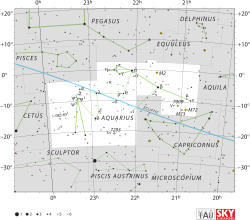| Observation data Epoch J2000 Equinox J2000 | |
|---|---|
| Constellation | Aquarius |
| Right ascension | 23h 26m 02.78566s[1] |
| Declination | –20° 38′ 31.251″[1] |
| Apparent magnitude (V) | 4.37[2] |
| Characteristics | |
| Spectral type | K4 III[3] |
| U−B color index | +1.815[2] |
| B−V color index | +1.431[2] |
| Variable type | Suspected[4] |
| Astrometry | |
| Radial velocity (Rv) | +15.7[5] km/s |
| Proper motion (μ) | RA: –50.72[1] mas/yr Dec.: –64.22[1] mas/yr |
| Parallax (π) | 11.51 ± 0.21 mas[1] |
| Distance | 283 ± 5 ly (87 ± 2 pc) |
| Details | |
| Radius | 33[6] R☉ |
| Surface gravity (log g) | 1.66[7] cgs |
| Temperature | 3980[7] K |
| Metallicity [Fe/H] | –0.20[7] dex |
| Other designations | |
| Database references | |
| SIMBAD | data |
99 Aquarii (abbreviated 99 Aqr) is a star in the equatorial constellation of Aquarius. 99 Aquarii is the Flamsteed designation, although it also bears the Bayer designation b2 Aquarii. It is visible to the naked eye with an apparent visual magnitude of 4.38;[2] according to the Bortle Dark-Sky Scale this is bright enough to be seen even from city skies under ideal viewing conditions. Based upon parallax measurements, the distance to this star is around 283 light-years (87 parsecs).[1]
This is a giant star with a stellar classification of K4 III.[3] It is a suspected variable star that apparently ranges in magnitude between 4.35 and 4.45.[4] The measured angular diameter of this star is 3.55 ± 0.21 mas.[9] At the estimated distance of Delta Ophiuchi,[1] this yields a physical size of about 33 times the radius of the Sun.[6] The outer atmosphere has an effective temperature of 3980 K,[7] giving it the orange-hued glow of a cool, K-type star.[10]
This star was a candidate member of the Ursa Major Moving Group based on the work of American astronomer Nancy Roman, but this membership is now in question.[11]
YouTube Encyclopedic
-
1/2Views:2 4619 186
-
AQUARIUS OCTOBER 2022 URGENT READING! SOMEONE IS PLANNING AN ATTACK! AQUARIUS OCTOBER TAROT READING
-
AQUARIUS ♒️ BLACK MAGIC RETURNED YOU A CREATIVE PSYCHIC
Transcription
References
- ^ a b c d e f g van Leeuwen, F. (November 2007), "Validation of the new Hipparcos reduction", Astronomy and Astrophysics, 474 (2): 653–664, arXiv:0708.1752, Bibcode:2007A&A...474..653V, doi:10.1051/0004-6361:20078357, S2CID 18759600.
- ^ a b c d Jennens, P. A.; Helfer, H. L. (September 1975), "A new photometric metal abundance and luminosity calibration for field G and K giants.", Monthly Notices of the Royal Astronomical Society, 172 (3): 667–679, Bibcode:1975MNRAS.172..667J, doi:10.1093/mnras/172.3.667.
- ^ a b Houk, Nancy (1978), Michigan catalogue of two-dimensional spectral types for the HD stars, vol. 4, Ann Arbor: Dept. of Astronomy, University of Michigan, Bibcode:1988mcts.book.....H.
- ^ a b Samus, N. N.; et al. (March 2012), "NSV 14554", General Catalog of Variable Stars, retrieved 2012-07-12.
- ^ Wilson, Ralph Elmer (1953), "General Catalogue of Stellar Radial Velocities", Carnegie Institute Washington D.C. Publication, Washington: Carnegie Institution of Washington, Bibcode:1953GCRV..C......0W.
- ^ a b Lang, Kenneth R. (2006), Astrophysical formulae, Astronomy and astrophysics library, vol. 1 (3rd ed.), Birkhäuser, ISBN 3-540-29692-1.. The radius (R*) is given by:
- ^ a b c d McWilliam, Andrew (December 1990), "High-resolution spectroscopic survey of 671 GK giants. I - Stellar atmosphere parameters and abundances", Astrophysical Journal Supplement Series, 74: 1075–1128, Bibcode:1990ApJS...74.1075M, doi:10.1086/191527.
- ^ "* 99 Aqr". SIMBAD. Centre de données astronomiques de Strasbourg. Retrieved 2012-07-11.
- ^ Richichi, A.; Percheron, I.; Khristoforova, M. (February 2005), "CHARM2: An updated Catalog of High Angular Resolution Measurements", Astronomy and Astrophysics, 431 (2): 773–777, Bibcode:2005A&A...431..773R, doi:10.1051/0004-6361:20042039.
- ^ "The Colour of Stars", Australia Telescope, Outreach and Education, Commonwealth Scientific and Industrial Research Organisation, December 21, 2004, archived from the original on March 18, 2012, retrieved 2012-01-16.
- ^ Chupina, N. V.; Reva, V. G.; Vereshchagin, S. V. (June 2006), "Kinematic structure of the corona of the Ursa Major flow found using proper motions and radial velocities of single stars", Astronomy and Astrophysics, 451 (3): 909–916, Bibcode:2006A&A...451..909C, doi:10.1051/0004-6361:20054009. See table 7.


